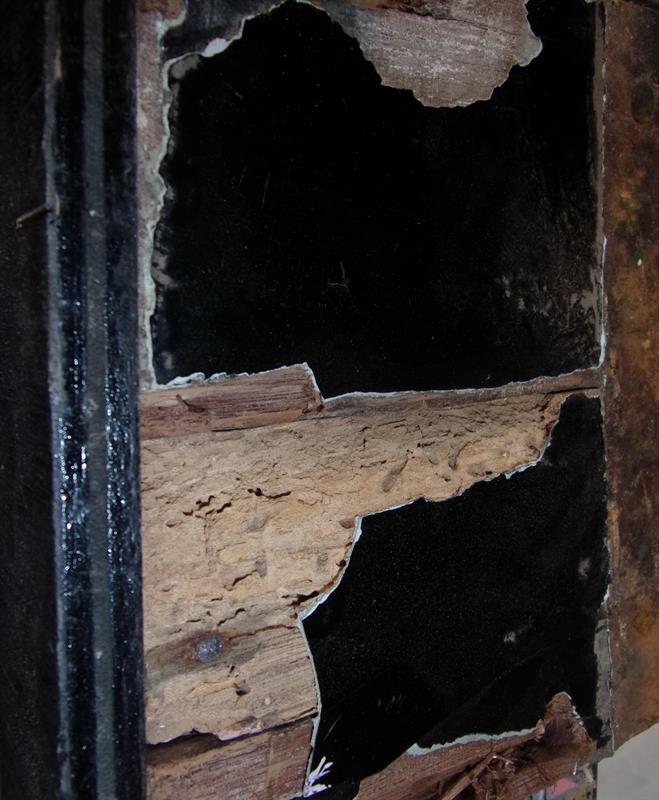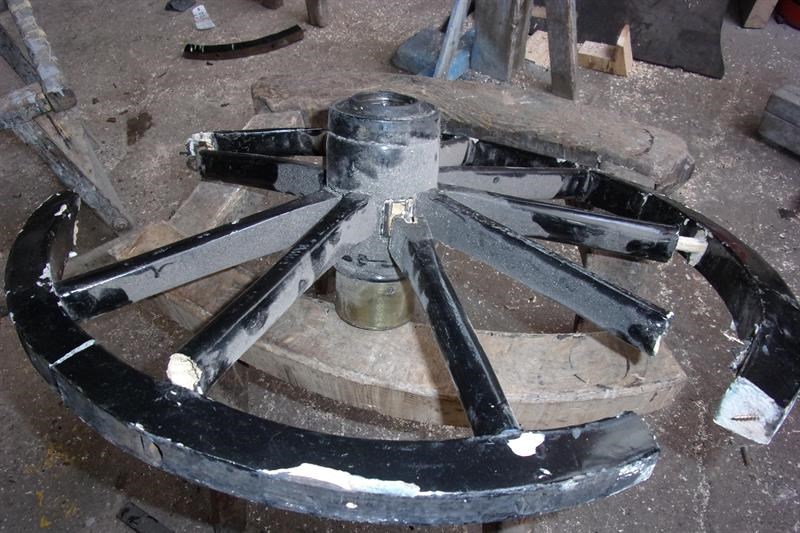Philip Holder from Wellington Carriage Company is a Yeoman of the Worshipful Company of Wheelwrights. For more than 50 years he has been restoring carriages, he gives us his expert advice on buying an authentic carriage. First published in Carriage Driving August 2019.

A bad corner panel joint filler has been used to hide wood worm and there is a rough Plywood edge
Looking for an original carriage can be quite a challenge, particularly to fit a horse or pony you already own. Genuine small pony carriages are particularly hard to find. Web sites and sales offer a wide choice, and good vehicles with a known history can sometimes be acquired privately. Reputable dealers, carriage builders, and restorers are another possible source. A sound unrestored carriage can be a good buy, but restoration cost can be considerable – this will be reflected in the price.
A potential purchaser not only needs an eye for elegance, style, and proportion, but a good basic knowledge of what faults to look for in the general construction. A carriage that has clearly been finished to a very high standard is unlikely to be hiding any significant faults. A roughly painted carriage, particularly if newly done, could be hiding some fairly serious problems.
When considering a carriage: does it look right, have wheels been cut down, or the body unreasonably blocked up in an attempt to fit a different size animal? Is it completely original, or is it made up using various iron work, wheels, and springs from different carriages? For instance – do the step treads all match? Be suspicious of Modern arc welding employed to join or alter iron parts, or add modern steel brackets. A good original wooden body should have well-made joints. Beware of loose broken joints that have been filled. Look under the body, or in any boot or enclosed areas where you might find wood worm, rot, or bad workmanship or repair. With the exception of certain slated sided vehicles, bolts and screws are not generally visible externally: modern pozidrive screws and hexagon nuts can indicate a poor repair or new body. Look out for poorly finished panel edges made from cheap plywood.
Remember prominent cracks in thin panels are difficult if not impossible to repair, and will inevitably show under a good paint finish. In an open carriage, seat cushions and floor mats should not be nailed down. This allows water and damp to remain under them, leading to detrition of the structure underneath, or they may possibly be already hiding a problem. Look for a build-up of rust between the spring leaves and on the underside for signs of decay.
Make sure that the body of a two wheel carriage is the right height when level, and the shafts are the right length and width to suit the horse or pony. In a vehicle that has been put together from various components the wheels can be too far forward or back, or the shafts set on badly. Hold the shafts so that the body is level and satisfy yourself the vehicle will balance. A gig without a sliding seat should balance with occupants seated when the axle is set about 3-4 inches back from the seat front edge.
Always pay particular attention to wheels and shafts look for hairline cracking round areas that have been filled or plated. Put your knee against the wheel hub, and try to pull the rim towards you – any movement in the joints can indicate a significant problem. Are the axles sound? A small amount of end play can be rectified with new leather washers, but rocking can indicate significant wear or even the wrong wheels for the axle. The brass caps should match, be sound, and not leak oil. All wheels have a certain amount of dish, but the spoke stood directly on the ground should be at 90 degrees when viewed from the rear of the carriage. Over dished wheels – particularly if spokes are bowed – will usually mean the wheel will not run true and indicate serious problems. The four wheels in a four wheeler should be of near identical construction (except for height) and the front wheels should not have more spokes than the back. If this not the case, it is almost certain that the wheels and axles are from two different vehicles. Look for any cracks in shafts, and any signs or rot or damage, particularly where they are attached with metal clips, plates, or brackets. Independent shafts for a four wheeled carriage are made from a small section of bent ash lined with iron plates, and it is important the wood is not filed or patched or, under irons, cracked. The fore carriage (turn table) should rotate freely up to the stop without rocking. Make sure the wood and iron components are not strained, bent, or damaged, and the pole for a pair is sound, a good fit, and the correct height. Has it been repaired or replaced with one made from unsuitable softwood?
Don’t reject a carriage with minor faults that can be put right, and bear in mind that sometimes reputable carriage builders use good reclaimed ironwork with a new body.
If you are unsure what to look for, take a knowledgeable friend or ask the advice of a known expert – but don’t rely on the word of a stranger, or buy a carriage from a photograph without seeing it. I know from experience that a traditional carriage built around the turn of the last century, which has been well kept and maintained, will not let you down. A bad one is not worth considering, however cheap.
www.wellingtoncarriagecompany.co.uk
First published in Carriage Driving August 2019
